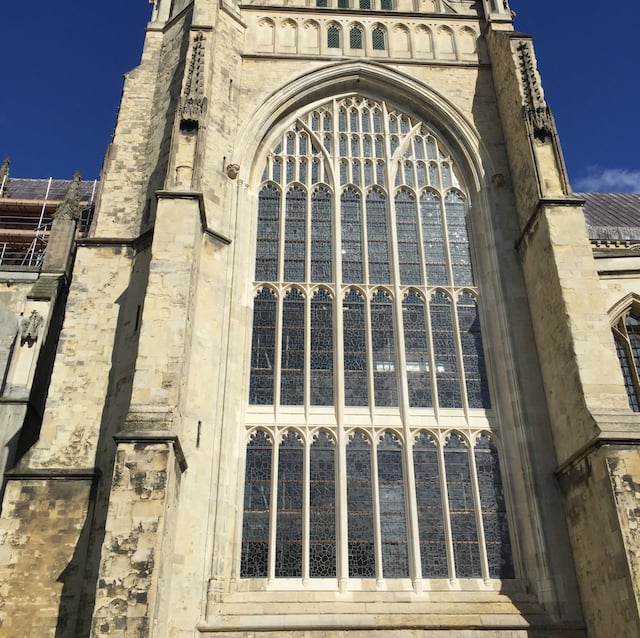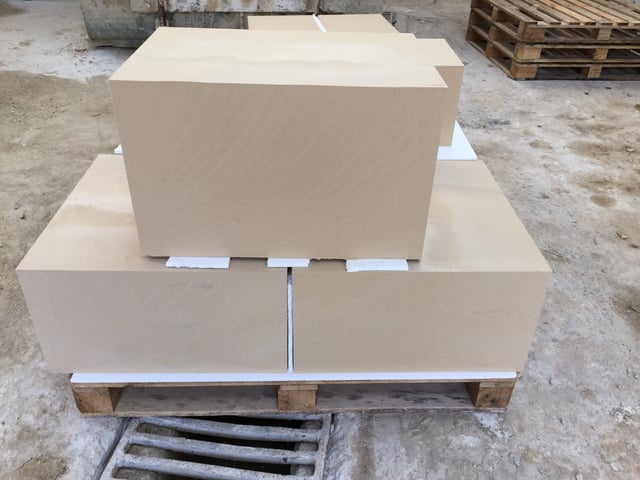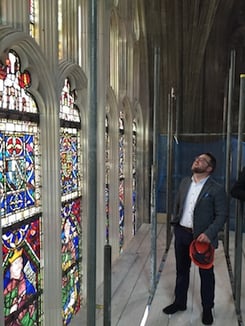Even as far back as the days of William the Conqueror, the French have always known a thing or two about stone. Almost one thousand years later, his buildings and his stone are still impressing us British.
The History of Caen French limestone in England
Dating back as far as the 11th century, some of the greatest English historic buildings were built with French stone. Canterbury Cathedral, Westminster Abbey and Tower of London were all built from Caen limestone which was brought over by WiIliam the Conqueror.

Canterbury Cathedral was rebuilt in 1070 AD using French limestone imported by WIlliam the Conqueror
But prior to that, Caen limestone was first used as a building stone by the Romans in the 1st century. Then, around a thousand years later, the quarry produced the limestone that was shipped to England following the Norman Conquest in 1066.
It was the preferred building stone of the Normans and was often used ahead of the local British stone. The Norman builders would have been familiar with the stone and, as it was quarried in their own land, it would probably have been easier and cheaper for them to use.
The Caen stone continued to be popular and in 1120, Reading Abbey was built from the stone. Coincidentally, the Abbey was once the home of Reading School which was my old secondary school. (It had long since moved to different premises elsewhere in Reading by the time I attended.) The now ruined Abbey is just a few miles from our Amarestone office.

New blocks of cut to size Caen limestone - nowadays in quite short supply
Notable examples of Caen stone buildings:
Wikipedia lists some examples of where this historic limestone has been used:
- Caen stone was used in the construction of the late 11th century austere Norman Romanesque Church of Saint-Étienne, at the Abbaye-aux-Hommes (on the east side of Caen), which was founded by William the Conqueror, whose tomb is located there.
- The Norman Romanesque Church of La Trinité, at the Abbaye-aux-Dames (on the west side of the city), was founded by William's wife, Matilda. Her tomb is located there.
- Both abbeys in Caen were built with Caen stone in Norman Romanesque style, and both were unscathed by heavy aerial bombing in July 1944 that destroyed much of the city, as they were being used by the local populace to shelter from the air raids.
- Used by the Normans for the cathedral and castle in Norwich, where it was brought by boat up the River Wensum. Caen stone was also used extensively in Canterbury cathedral. It was used by Henry I of England at Reading Abbey and fine examples of Romanesque sculpture in Caen stone are in the collection at the Museum of Reading. Perhaps the most famous building in Caen stone built in Norman times is the Tower of London.
- Caen stone continued to be a popular material in Britain after the Norman period. For example, it was used for parts of the 19th century clock tower at the Palace of Westminster.
- Caen stone has also been exported to the USA, Bermuda and recently Saudi Arabia.
[List taken from Wikipedia: https://en.wikipedia.org/wiki/Caen_stone]
 Recently, the supply of Caen limestone in any quantity has become more difficult as the bed of good quality stone in the quarry is diminishing. So in order to maintain a supply of limestone that can be used for the restoration and repair of these historic buildings, efforts have been made to identify alternatives from other quarries that have similar properties.
Recently, the supply of Caen limestone in any quantity has become more difficult as the bed of good quality stone in the quarry is diminishing. So in order to maintain a supply of limestone that can be used for the restoration and repair of these historic buildings, efforts have been made to identify alternatives from other quarries that have similar properties.
One such stone is Lavoux from the south west of France. This stone has been approved for the restoration work currently taking place at Canterbury Cathedral and has also been used extensively in York Minster, Gloucester and other UK cathedrals and heritage buildings.
The image here shows one of Canterbury's own stonemasons showing me the new Lavoux limestone in place in the Great South Window at Canterbury. The cut to size rectangular blocks were delivered to the masons who then carved the intricate tracery that holds the centuries old stained glass windows that are such a famous part of the cathedral.
For more details of French Limestone, please visit our main web site.
If you would like to know more about Amarestone, please download our brochure which explains how we work and how we can help your natural stone project be successful.
Join our mailing list to get a copy of the next blog direct to your email inbox.
Are there any aspects of using, choosing or maintaining natural stone that you would like us to cover? Tell us by adding your comment to the box below. We love getting your feedback and are here to help.
Thanks for reading.
Steve Turner
0345 260 8070
Amarestone


